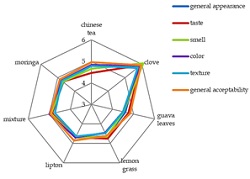Formulation, Organoleptic Evaluation, and Acceptability of Various Teas from Underutilized Nutritious Herbs Compared with Marketed Chinese and Yellow Lipton Tea
Abstract
Herbal teas are nutrient, antioxidant, and hydration-rich brews made from herbs and spices and taken for various purposes. The objective of this study was to formulate tea from clove (Syzygium aromaticum), leaves of lemongrass (Cymbopogon citratus), guava (Psidium guajava), and moringa (Moringa oleifera), as well as compared with Chinese and yellow Lipton Tea. The samples were analyzed for comparative sensory analysis using the 7 points hedonic scale. The sensory evaluation result demonstrated that the color of the clove tea sample (5.87) was most acceptable by participants, while the lemongrass tea (4.46) sample was least acceptable amongst all the tea samples. The clove remained the most accepted tea for aroma (6.07), taste (5.92), texture (5.76), general appearance (5.74), and general acceptability (5.93), in 7 points hedonic scale. However, all tea samples were had significant acceptable scores above average (p <0.05). Owing to the above results, these herbs can be successfully used to produce tea of relatively good quality to encourage herbs' local consumption and stay healthy.
Full text article
References
2. Pieroni A, Torry B. Does the taste matter? Taste and medicinal perceptions associated with five selected herbal drugs among three ethnic groups in West Yorkshire, Northern England. J Ethnobiol Ethnomedicine. 2007;3:21. doi:10.1186/1746-4269-3-21
3. Adnan M, Ahmad A, Ahmed A, Khalid N, Hayat I, Ahmed I. Chemical composition and sensory evaluation of tea (Camellia sinensis) commercialized in Pakistan. Pak J Bot. 2013;45(3):901-7.
4. Chaturvedula VSP, Prakash I. The aroma, taste, color and bioactive constituents of tea. J Med Plants Res. 2011;5(11):2110-24. doi:10.5897/JMPR.9001187
5. El Sheikh R, Amin AS, Atwa MA, Gouda AA, Abdullah AA. Determination of Phenolic Components and Antioxidant Activity of Some Egyptian Tea Samples. Int J Pharm Pharm Sci. 2015;7(4):198-202.
6. Khan N, Mukhtar H. Tea and Health: Studies in Humans. Curr Pharm Des. 2013;19(34):6141-7. doi:10.2174/1381612811319340008
7. Hajdari A, Mustafa B, Hyseni L, Bajrami A, Mustafa G, Quave CL, et al. Phytochemical Study of Eight Medicinal Plants of the Lamiaceae Family Traditionally Used as Tea in the Sharri Mountains Region of the Balkans. ScientificWorldJournal. 2020;2020:4182064. doi:10.1155/2020/4182064
8. Huang D, Ou B, Prior RL. The chemistry behind antioxidant capacity assays. J Agric Food Chem. 2005;53(6):1841-56. doi:10.1021/jf030723c
9. Drewnowski A, Gomez-Carneros C. Bitter taste, phytonutrients, and the consumer: a review. Am J Clin Nutr. 2000;72(6):1424-35. doi:10.1093/ajcn/72.6.1424
10. Tang GY, Meng X, Gan RY, Zhao CN, Liu Q, Feng YB, et al. Health Functions and Related Molecular Mechanisms of Tea Components: An Update Review. Int J Mol Sci. 2019;20(24):6196. doi:10.3390/ijms20246196
11. Bhuyan LP, Borah P, Sabhapondit S, Gogoi R, Bhattacharyya P. Spatial variability of theaflavins and thearubigins fractions and their impact on black tea quality. J Food Sci Technol. 2015;52(12):7984-93. doi:10.1007/s13197-015-1968-z
12. Zou G, Xiao Y, Wang M, Zhang H. Detection of bitterness and astringency of green tea with different taste by electronic nose and tongue. PLoS One. 2018;13(12):e0206517. doi:10.1371/journal.pone.0206517
13. Lee J, Chambers DH. Sensory descriptive evaluation: brewing methods affect flavour of green tea. Asian J Food AgroIndustry. 2009;2(4):427-39.
14. Nakagawa M. Contribution of Green Tea Constituents to the Intensity of Taste Element of Brew. Nippon Shokuhin Kōgyō Gakkaishi. 1975;22(2):59-64. doi:10.3136/nskkk1962.22.59
15. Granato D, Masson ML, Ribeiro JCB. Sensory acceptability and physical stability evaluation of a prebiotic soy-based dessert developed with passion fruit juice. Ciênc Tecnol Aliment. 2012;32(1):119-25. doi:10.1590/S0101-20612012005000004
16. Dhifi W, Bellili S, Jazi S, Bahloul N, Mnif W. Essential Oils’ Chemical Characterization and Investigation of Some Biological Activities: A Critical Review. Medicines. 2016;3(4):25. doi:10.3390/medicines3040025
17. Lonkar PB, Chavan UD, Pawar VD, Bansode VV, Amarowicz R. Studies on Preparation and Preservation of Lemongrass (Cymbopogon flexuosus (Steud) Wats) Powder for Tea. Emir J Food Agric. 2013;25(8):585-92. doi:10.9755/ejfa.v25i8.15218
18. Ochanda SO, Wanyoko JK, Ruto HK. Antioxidant Capacity and Consumer Acceptability of Spiced Black Tea. J Food Res. 2015;4(6):104-12.
19. Yashin A, Yashin Y, Xia X, Nemzer B. Antioxidant Activity of Spices and Their Impact on Human Health: A Review. Antioxidants. 2017;6(3):70. doi:10.3390/antiox6030070
20. Chacko SM, Thambi PT, Kuttan R, Nishigaki I. Beneficial effects of green tea: A literature review. Chin Med. 2010;5:13. doi:10.1186/1749-8546-5-13
Authors
Authors continue to retain the copyright to the article if the article is published in the Borneo Journal of Pharmacy. They will also retain the publishing rights to the article without any restrictions.
Authors who publish with this journal agree to the following terms:
- Any article on the copyright is retained by the author(s).
- The author grants the journal, right of first publication with the work simultaneously licensed under a Creative Commons Attribution License that allows others to share work with an acknowledgment of the work authors and initial publications in this journal.
- Authors are able to enter into separate, additional contractual arrangements for the non-exclusive distribution of published articles of work (eg, post-institutional repository) or publish it in a book, with acknowledgment of its initial publication in this journal.
- Authors are permitted and encouraged to post their work online (e.g., in institutional repositories or on their websites) prior to and during the submission process, as can lead to productive exchanges, as well as earlier and greater citation of published work.
- The article and any associated published material are distributed under the Creative Commons Attribution-ShareAlike 4.0 International License.




